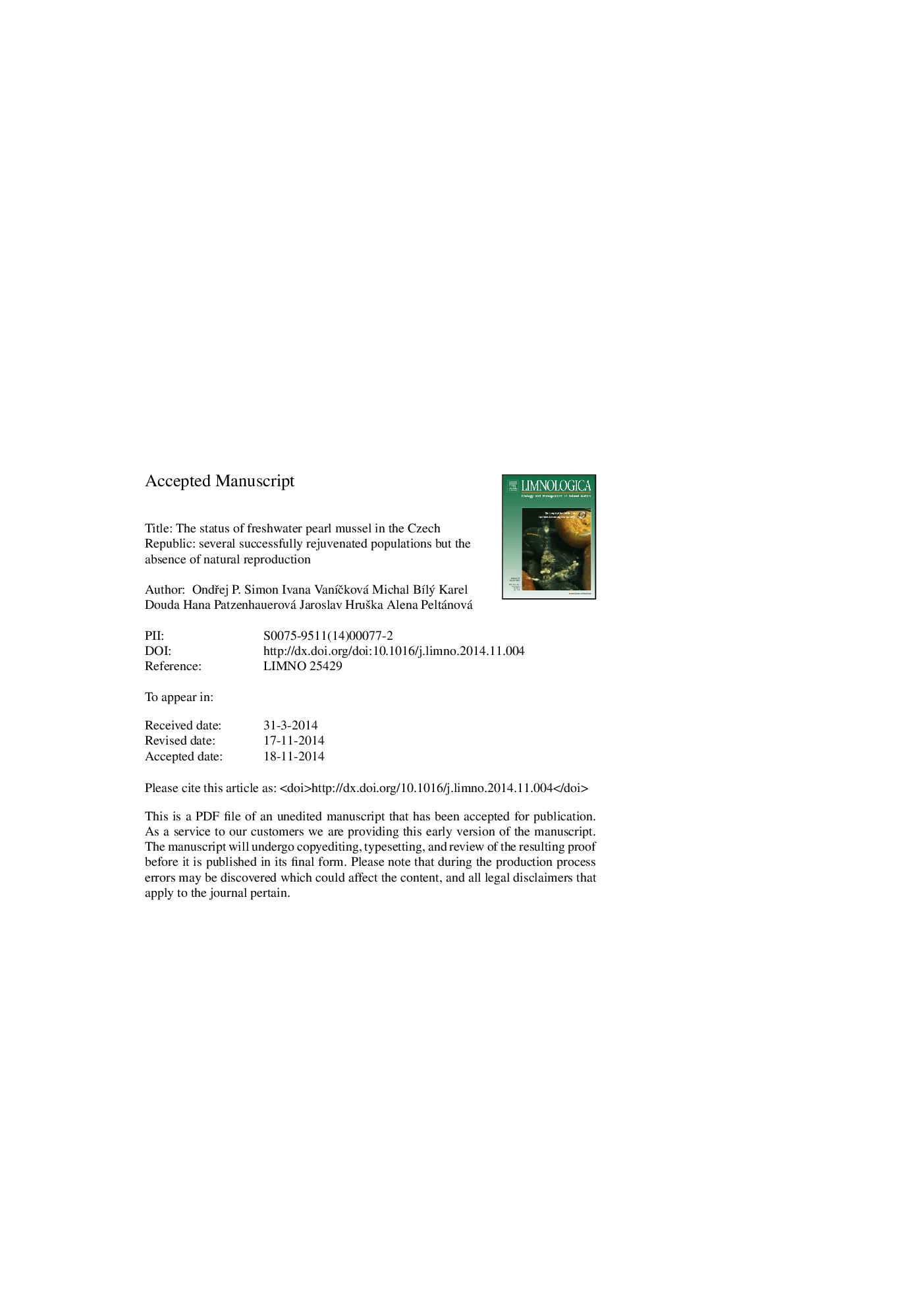| کد مقاله | کد نشریه | سال انتشار | مقاله انگلیسی | نسخه تمام متن |
|---|---|---|---|---|
| 6305568 | 1618572 | 2015 | 23 صفحه PDF | دانلود رایگان |
عنوان انگلیسی مقاله ISI
The status of freshwater pearl mussel in the Czech Republic: Several successfully rejuvenated populations but the absence of natural reproduction
ترجمه فارسی عنوان
وضعیت مایع مروارید آب شیرین در جمهوری چک: چندین جمعیت جوان را جوان سازی کرده اند، اما عدم تولید طبیعی
دانلود مقاله + سفارش ترجمه
دانلود مقاله ISI انگلیسی
رایگان برای ایرانیان
کلمات کلیدی
ترجمه چکیده
مسیحی مروارید آب شیرین از لحاظ تاریخی در بسیاری از رودخانه ها و رودخانه ها در رودخانه های الب، رودرن و حوضه دانوب در جمهوری چک، مرکزی اروپا فراوان بوده است. در قرن بیست و یکم، صدف ها در ارتفاعات پایین و متوسط منقرض شده اند و جمعیت های فعلی در نزدیکی حد بالای دامنه طبیعی خود قرار دارند. جمعیت فعلی این گوساله تخمین زده شده است که تنها 1٪ از فراوانی تاریخی است. کاهش جمعیت مربوط به اثرات منفی آلودگی از صنعت، کشاورزی شدید، جنگلداری و فاضلاب بود. زیستگاه مروارید آب شیرین نیز تحت تاثیر مقررات جریان آب قرار گرفته است و توسط سدها و حوضه ها تقسیم شده است. تمام این تأثیرات منجر به شکست چرخه تولید مثل شده است. آخرین گروه قابل توجه نوجوانان تقریبا 30 تا 40 سال پیش برآورده شد. بنابراین، این گونه به شدت در معرض خطر قرار می گیرد و برنامه ای برای حفاظت از جمعیت در جمهوری چک ایجاد شده است. در سالهای 1984 تا 2005، اقدامات ویژه ای برای بهبود ساختار سنی سالمندان انجام شد. ماهی های آلوده به میلیون ها گلچیده در دو محل منتشر شد و بیش از 53 هزار نوجوان جوان که سه تا پنج سال سن داشتند در 7 محل زندان آزاد شدند. تنها راه دوم منجر به تعداد کمی از زیردولت ها شد که به تدریج از زیر بنا به سطح پایینی ظاهر شد، همانگونه که توسط نظارت بر تلاش ها تایید شد. علیرغم تلاش های همزمان برای احیای زیستگاه صدف در 25 سال گذشته، تولید مثل طبیعی در جمهوری چک هنوز رخ نمی دهد. بنابراین، بازسازی کامل جریانهای الیگوتروفیک، کلید حضور و بازتولید طبیعی مسیحی های آب شیرین در جمهوری چک می باشد.
موضوعات مرتبط
علوم زیستی و بیوفناوری
علوم کشاورزی و بیولوژیک
علوم آبزیان
چکیده انگلیسی
The freshwater pearl mussel was historically abundant in many streams and rivers in the Elbe, Oder, and Danube Basins in the Czech Republic, Central Europe. By the 21st century, the mussels had become extinct in the lower and middle altitudes, and current populations are only present near the upper limit of their natural range. The current population of this mussel is estimated to be only 1% of the historical abundance. The population decline was related to the negative impacts of pollution from industry, intense agriculture, forestry, and sewage water. The freshwater pearl mussel habitat has also been impacted by watercourse regulations and has been fragmented by dams and weirs. All of these impacts have resulted in failure of the reproductive cycle; the last significant cohort of juveniles settled approximately 30 - 40 years ago. Therefore, this species is considered critically endangered, and an action plan was developed to conserve the populations in the Czech Republic. Special measures were conducted between 1984 and 2005 to improve the age structure of elderly populations. Fish infected with millions of glochidia were released in two locations, and over 53,000 captive-bred juveniles that were three to five years old were released in seven locations. Only the latter approach resulted in a small number of subadults that gradually emerged from the substratum to the bottom surface, as confirmed by monitoring efforts. Despite simultaneous efforts to restore mussel habitat over the last 25 years, natural reproduction still does not occur in the Czech Republic. Therefore, complete restoration of oligotrophic streams is the key to the future presence and natural reproduction of freshwater pearl mussels in the Czech Republic.
ناشر
Database: Elsevier - ScienceDirect (ساینس دایرکت)
Journal: Limnologica - Ecology and Management of Inland Waters - Volume 50, January 2015, Pages 11-20
Journal: Limnologica - Ecology and Management of Inland Waters - Volume 50, January 2015, Pages 11-20
نویسندگان
OndÅej P. Simon, Ivana VanÃÄková, Michal BÃlý, Karel Douda, Hana Patzenhauerová, Jaroslav HruÅ¡ka, Alena Peltánová,
